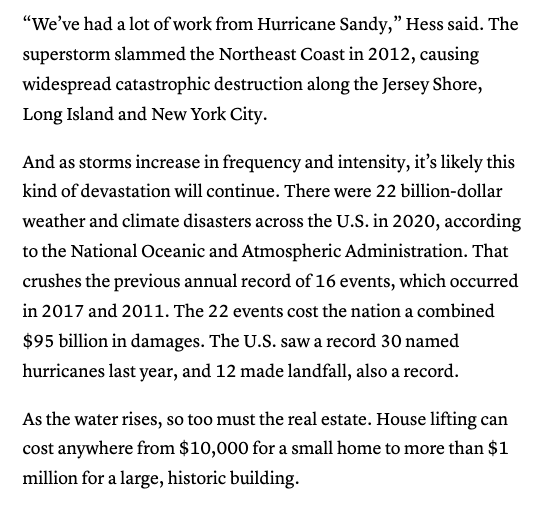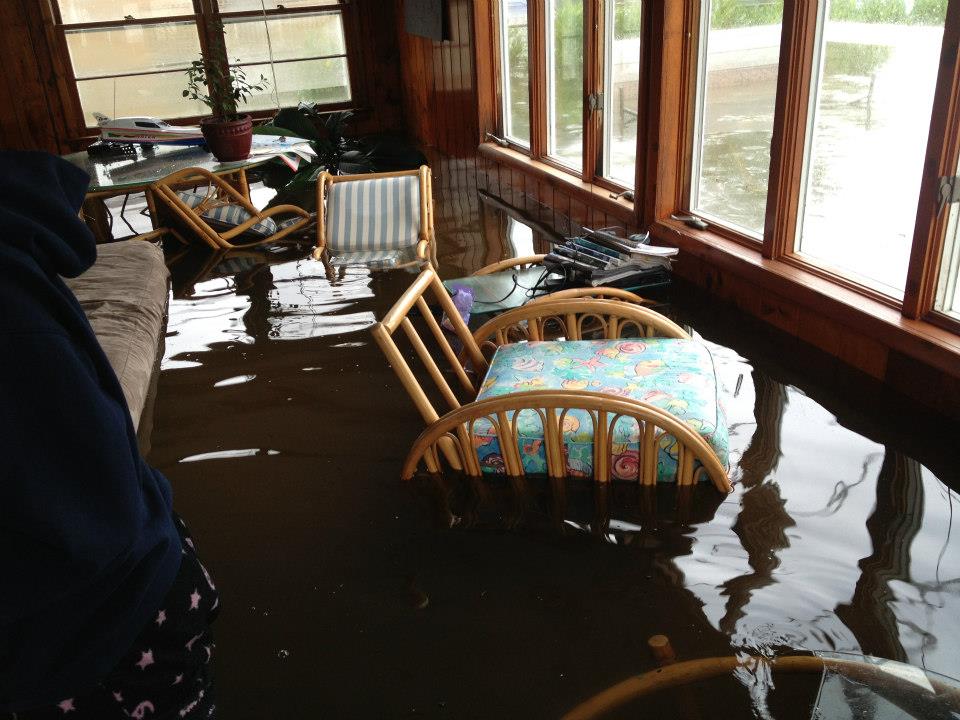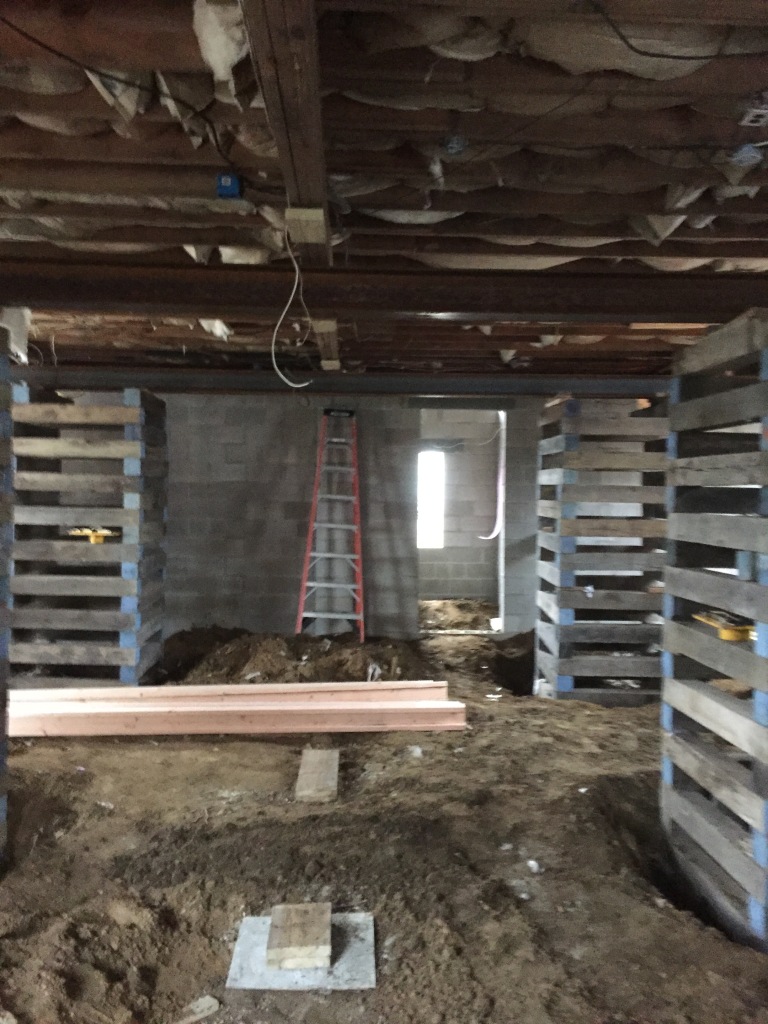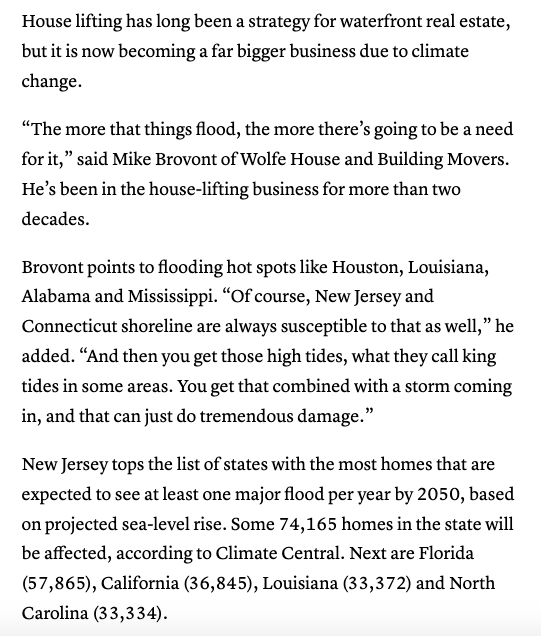What you may not know is that the hypothetical climate displacement that people talk about has already happened to you. That it has changed you, that it has changed your family. That it is not extraordinary. That it is not hypothetical after all.

In October 2012, my father’s house was flooded with four feet of water, essentially evicting us for the duration of the repairs. These repairs—which included the process of lifting the house, as was required for us to receive disaster compensation from FEMA, and so we were in compliance with local building codes and insurance requirements—would take the next few years. We wouldn’t move back in fully until 2018.

What did this feel like at the time, as it was happening? I remember driving in the car with my mom the day after, traveling from my aunt’s house where we were riding out the storm back to our town around 20 minutes away. All of the lights were off—on all the billboards, the LED signs of the shops we would pass, the homes with their darkened windows, everything fairly still save for the people lining up to buy generators in the Home Depot parking lots. On the street where my mom’s house stands there was a massive tree down. It had taken the power lines down with it, leaves and wet pavement everywhere, the water still receding at the end of the street where it had crept up and submerged half of the neighborhood. Lucky us, all we got was a flooded basement. Less lucky were all of our utilities and the boxes of family heirlooms which we kept down there. All just things. But all now gone. It would take a few weeks to get our heat and plumbing back, and longer to rework the infrastructure of the house in anticipation of the next flood.
My dad’s house was in the next town over. We couldn’t get to it. The street was still heavily flooded. We would’ve needed a kayak to reach the front door. Instead of heading inland like us, my father, stepmother, and stepsister had decided to stay, and were still inside. It’s not like we could call them, with the phone lines and Internet down everywhere, so we turned around and left.
Later I’d find out that they ended up sheltering on the second floor, where, if they were to walk out onto the landing of the staircase leading down to the first, they could see all of the furniture floating in murky water from the creek out back, which had made its way into the house. It would’ve been around chest-level if they were to step down into it.
This, the action of nature, was the least of it all.

In a coastal town, Sandy had some degree of effect on everyone who lived there, to say nothing of the chaos it wrought on those further north who had very little immediate or long-term help in sight for them. It would become something of a conversation piece for the locals. Years later I find it still keeps coming up when I talk to someone else from New Jersey or New York.
In the midst of this shared destruction, what I wasn’t able to realize at the moment was that displacement is not something that has a precise or finite limit to it. It’s not just about location. What you will experience when this happens (and it will happen, and it will happen, and it will happen) is a displacement not only of the body or of the water or of the soil but of the entire self. It sounds hyperbolic, but let me explain a little further, so that you understand that displacement is not just something that occurs to you, but something that you absorb and internalize and experience in continual aftershocks until you yourself take on a complete and permanent state of being displaced.

What would follow in the years since was a seismic shift in how my family lived and worked. Not necessarily just geographically, though there was some of that—for over a year my dad shared time between our damaged house and his girlfriend’s over an hour north. After that we stayed in a rental. He would come back whenever he could, doing whatever he could to dispose of the ruined furniture, to take apart the ruined floor, to remake the house that we had just moved into a few years earlier so that we could hope to live in it again. I remember when the walls were all gouged out and rebuilt, myself and my siblings were given permission to leave secret drawings and messages on the wooden frame of the house that would soon be covered up with layers of insulation and plaster and paint. I remember him caked in mud from spending hours in the crawlspace down below.

He, like the house, was transforming. The money from government aid programs wasn’t enough, and rebuilding the house for permanence felt a somewhat futile struggle. I’m not sure what the internal processes he went through looked like, but to me, standing on the sidelines of it all, I saw someone who was repeatedly bested by time and nature and circumstance trying to prove that he wasn’t bested after all, that he was willing to dedicate himself in his entirety for the reward of belonging, even if the reward itself wasn’t worth it, or wasn’t even attainable beyond face value.

Meanwhile, we were transforming too. It was a family affair. Life progressed on with its usual and more ordinary afflictions. All additional displacements on top of the initial one, but compounded now, rewriting for us the meaning of ‘instability’ to include new and expanded definitions.
None of this came without consequence, but it was the sort of rolling consequence that you don’t feel in its full immediacy until you have a chance to really step back and look at it. Displacement is no stranger to children of an unstable family life (followed in our case by an ugly divorce), and the way that the climate displacement brought by Sandy played out upon us was actually pretty similar. There’s the initial event of it, which serves mostly to mark different segments of your life as “the time before this” and “the time after this,” a clean cut between past and present that is itself marked by a million more messy deviations and blurred lines of repercussion that makes the self before it happened into some kind of naive, unrecognizable stranger. And as for the self after it happened, it’s like I said before: you take on displacement as a permanent state of being, a permanent condition of your existence. It happens in small ways and big ways and ways you never even think to mention, but it happens nonetheless.

I think that, especially for the adults in our family, our displacement during Sandy added one more thing to the list of threats to the stability and security they thought was supposed to have been attained by now, that was felt to be deserved after years of working towards the promise of it. The economy could change (and with it your chance of ever living free of crushing debt), your relationships with the people you love could change, your health and your mind could change and break in all sorts of ways—all of these things could change at the drop of the hat, and now your home could be taken from you over the course of one night by a surge of sea. When all of these things can change and do change, over and over, you start to feel a bit like there’s nothing in the world left to be trusted. You form preemptive defenses against the things that have yet to betray you, because in your mind it’s always a matter of ‘yet’, never a matter of ‘if.’ You start to doubt the idea that there is an objective time, an objective truth, an objective principle of what is just and unjust, right and wrong, fair and unfair, immutable and unfixed.
What good is the concept of resilience against total detachment?

We lost our home during a hurricane in 2012, and I can’t remember a single thing that was the same after that, save for a few walls and windowpanes.
My dad is still paying off the debt he was put in by the house, which itself still isn’t finished, at least not in the way that he thought it would be. There are still bare wooden planks holding parts of it up, cold cement where he envisioned smooth stone and warm wood. This debt was something that would loom over all of us in ways both subtle and overt—a financial displacement that far exceeded and outlasted the displacement of the wind and tide that brought it to be. We all learned that whatever excess there might be was to be fed to the house, not to the people living in it. We learned how to take care of ourselves in many ways, took moments of rest by force or by the neck of a bottle, and still felt undeserving of them. And upon each other we would rest the frustration and exhaustion of it all, the space we shared no bigger for it, and not nearly big enough to hold its own weight.
Each of us have felt it as a constant negotiation between the way we thought things would be by now and the way things are. We have had to prioritize. And the choices you make when you start to prioritize, when the priorities you have to choose from are things like family, finances, shelter, empathy, self, are choices you will have to reckon with for the rest of your life. They are choices about what will be allowed to survive, and what will continue to be displaced until it gets the hint and disappears for good.

We lost our home during a hurricane in 2012, and a version of it is still there, or is it? Instead of creating a more permanent place to settle into, the house became emblematic of the end of childhood, the end of permanence, and the end of home.
Each of us have been changed, and changed since, an ongoing process of alienation not only from our house and from each other, but from the very idea that there is a place where we belong. For some of us it’s because we don’t feel like we deserve belonging, for some of us it’s because we’ve decided that the concept of ‘belonging’ has long since been disproved, for some of us it’s because we don’t have the energy to get our hopes up anymore, or won’t survive another disappointment.
And so it will continue onward indefinitely. It is a process that started before the hurricane, but which now stands upon a new four foot tall foundation of solid concrete, de-grounding us, transporting us ever upwards and away from the earth.

As flood risk increases, the cost of flood insurance rises. According to the estimates of Brooklyn-based group First Street, homes in my county will soon experience a 245% increase in the price of flood insurance annual premiums—we’re currently paying an average of $2,157 per year, which will increase to around $7,433 per year.
The National Flood Insurance Program’s Risk Rating 2.0 will likely use a similar model to determine the actual new insurance rates, which will go into effect October 1 of this year. Under this new formula, each home will receive an individual rating, as opposed to rates being determined by regional maps created by FEMA.
According to Flood Factor, the flood risk for my mother’s house is ranked as “major.” Expected loss of value to the building’s structure over the next 15 years is estimated at around $2,500, but with only an 11% risk of an inch of water reaching the house within that time frame.
The flood risk for my father’s house is ranked as “extreme.” Expected loss of value to the building’s structure over the next 15 years is estimated at around $330,800. The risk of at least twelve inches of water reaching the house within the next 15 years is 99%.
